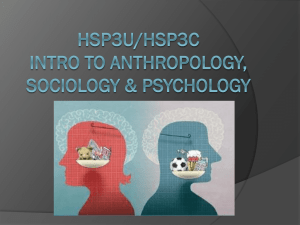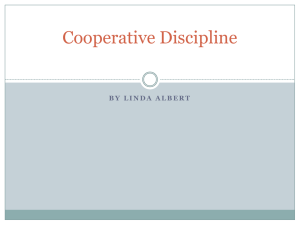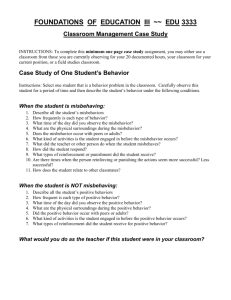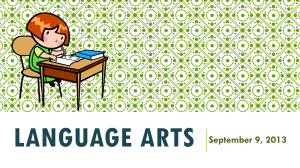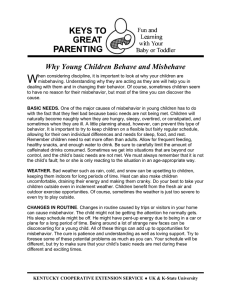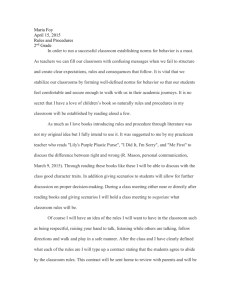Effective teaching and effective classroom management one and the
advertisement
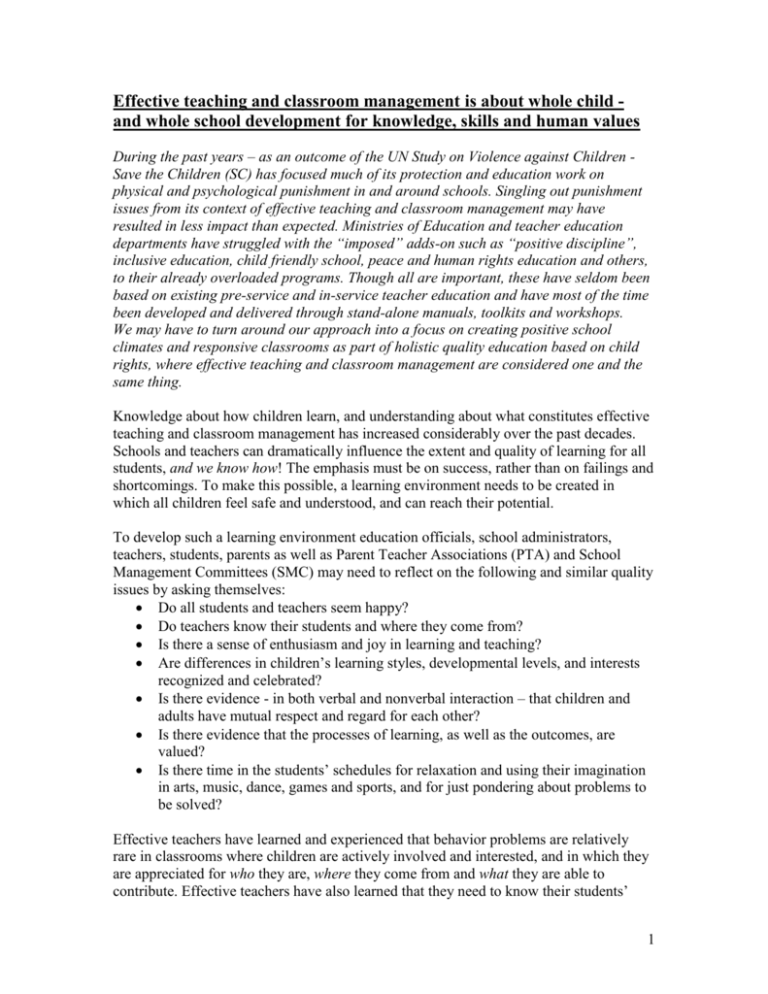
Effective teaching and classroom management is about whole child and whole school development for knowledge, skills and human values During the past years – as an outcome of the UN Study on Violence against Children Save the Children (SC) has focused much of its protection and education work on physical and psychological punishment in and around schools. Singling out punishment issues from its context of effective teaching and classroom management may have resulted in less impact than expected. Ministries of Education and teacher education departments have struggled with the “imposed” adds-on such as “positive discipline”, inclusive education, child friendly school, peace and human rights education and others, to their already overloaded programs. Though all are important, these have seldom been based on existing pre-service and in-service teacher education and have most of the time been developed and delivered through stand-alone manuals, toolkits and workshops. We may have to turn around our approach into a focus on creating positive school climates and responsive classrooms as part of holistic quality education based on child rights, where effective teaching and classroom management are considered one and the same thing. Knowledge about how children learn, and understanding about what constitutes effective teaching and classroom management has increased considerably over the past decades. Schools and teachers can dramatically influence the extent and quality of learning for all students, and we know how! The emphasis must be on success, rather than on failings and shortcomings. To make this possible, a learning environment needs to be created in which all children feel safe and understood, and can reach their potential. To develop such a learning environment education officials, school administrators, teachers, students, parents as well as Parent Teacher Associations (PTA) and School Management Committees (SMC) may need to reflect on the following and similar quality issues by asking themselves: Do all students and teachers seem happy? Do teachers know their students and where they come from? Is there a sense of enthusiasm and joy in learning and teaching? Are differences in children’s learning styles, developmental levels, and interests recognized and celebrated? Is there evidence - in both verbal and nonverbal interaction – that children and adults have mutual respect and regard for each other? Is there evidence that the processes of learning, as well as the outcomes, are valued? Is there time in the students’ schedules for relaxation and using their imagination in arts, music, dance, games and sports, and for just pondering about problems to be solved? Effective teachers have learned and experienced that behavior problems are relatively rare in classrooms where children are actively involved and interested, and in which they are appreciated for who they are, where they come from and what they are able to contribute. Effective teachers have also learned that they need to know their students’ 1 background to be able to understand non-academic factors that may impact their behavior, participation and learning. It is obvious that not all children learn at the same pace or in the same way. Schools and teachers may have to consider the extent to which education policies and practices lead to the labeling of children or to promoting the view that learning capacities are either limited or fixed. Educating the whole person is an important goal of education in itself and teachers play their part in this process, by taking into account and responding to individual differences in development and learning needs in each classroom. How a teacher perceives behavior management depends on how he1 sees his job as a teacher and to what extent he believes that all children can learn. Learning outcomes and behavior are aspects of education which are very much influenced by teaching quality. A teacher has control over many factors that influence motivation, achievement and behavior of students. Factors such as a classroom’s physical environment, a child’s level of emotional comfort and the quality of communication between teacher and students are important factors that enable or disable optimal learning of individual children. To be able to manage problems of students requires insight into where these difficulties may come from and why and when they arise. A teacher has to care for many different students, including those from poor, disadvantaged families, students who may have to work before or after school, children from different ethnic, religious or language minority groups and those with a variety of learning difficulties or disabilities. Children may come to school hungry or tired, they may not have been able to do home-work because of lack of electricity or parents who are illiterate and not able to help them with their school assignments. It is important for a teacher to know a child’s socio-economic and family background to be able to understand these non-academic or social factors that influence learning and behavior. These factors cannot directly be altered, but understanding them will enable a teacher to place a student’s “learning failure” or “misbehavior” in perspective and create learning environments that reduce rather than increase the effects of such. Children may be at risk of negative and meaningless school experiences if a teacher does not understand the whole child and his/her background, and is not ready with responsive, effective instruction and classroom strategies. When seeking explanations for lack of achievement or for behavior problems, a teacher needs to be prepared to consider inadequacies in the learning content, process and environment rather than inadequacies in the child. He needs to reflect on what he teaches and how he teaches. What does he say and do in the classroom to develop understanding? How does he introduce new topics? Does he spend enough time explaining purpose and relationship to previously taught information and skills to enhance developmental learning? A teacher must however not only look at social backgrounds, but also at what happens inside the classroom. How students behave is often a reaction to factors within the school. A teacher needs to reflect on the learning environment he has created and whether this engages all children actively and meaningfully. It is important for a teacher to investigate 1 Though ‘he’ is used throughout this paper, it applies to both male and female teachers 2 how his style of teaching can affect progress and behavior of different students. Timing of teaching-learning interactions is an essential part of classroom management and many behavior problems can be avoided by improved management of the classroom environment and timing of classroom activities. Effective teachers and classroom managers address the needs of children both in terms of what they teach and how they teach. Though teaching is generally a group activity, learning is very individual. Effective teachers are sensitive to these differences and take actions to accommodate these so that, ideally, each child is provided an optimal learning experience. Teachers for example decide where children sit in the classroom. This may appear an unimportant decision, but it is not. The seating arrangement in a classroom can enable or disable interaction, as well as impact student behavior and attitudes. Thus, it is important to decide who will sit where and during which activity, based on the teacher’s knowledge of his/her students. Research shows that children sitting farthest away from the teacher have the fewest interactions with them, are the least involved in classroom activities, and have the lowest achievement scores. Implications of such findings are obvious: teachers need to find ways to be physically close to their students, especially those who experience problems with learning. A teacher who manages his classroom by walking around can be close to every learner at different times. Therefore, a pair of comfortable walking shoes may be a necessary teaching tool…… Apart from imparting knowledge and skills, teachers also help children to define who they are. From daily interactions with teachers, children learn whether they are important or insignificant, bright or slow, liked or disliked. Teachers transmit these messages by the way they speak to children, their facial expressions and gestures, and by the amount of time they devote to each individual learner. Often teachers point out students’ deficiencies more than praising them for their efforts and (small) improvements. For 3 many children this is very discouraging, and may result in feelings of inferiority and failure. A teacher needs to realize this. From the messages that students receive, they decide whether they are willing to risk participation in classroom activities or not. Effective teachers recognize that such involvement does not always come easy - it requires a trusting, psychologically comfortable learning environment. A quality, essential to a psychological comfortable classroom environment is mutual respect. Too often, discussions related to respect focus mainly on the necessity of students respecting teachers. However, teachers and students must respect each other and respect has to be earned by both. It has to do with the way teachers and children interact. Students may have negative classroom experiences because they are ridiculed by teacher or peers, or they repeatedly hear that they are disruptive or slow or “dumb”. These and other negative messages telling children that they are not valued or respected, often result in children giving up on classroom participation. Research on teacher-student interaction shows that teachers often behave differently towards individual students based on their own perception of what a student can of cannot do. Students labeled as “low-achievers” get less opportunities to participate, and those perceived as “disruptive” are treated as such, even when behaving. To be successful as a teacher, he must attend to what students do, what they say and how they perform. Teachers should observe children’s reactions in class to find out whether they are ‘getting across’ to them. Thus, teaching is not a matter of reading from a textbook, or dictating notes, but a participatory process. Teachers rely on a variety of ‘signals’ from their students. ‘Eyes on’ behavior means students are paying attention. Squirming behavior means they are tired or bored. Affirmative nods of the head mean they follow and understand; puzzled looks mean they are confused…… 4 The major decision that teachers make on the basis of their observations of children is when it is appropriate to move on to the next topic, problem or issue. Some teachers though are ‘clock or calendar watchers’ more then ‘student watchers’ and feel compelled to cover a certain amount of material within a certain time. Teachers need to reflect on their assumptions and expectations by asking children for feedback on the teaching-learning process and on what happens in the classroom in general. Teachers can learn from students. It is important for teachers to know what makes a good teacher in the eyes of his students. Such characteristics of quality teachers almost always have to do with a teacher’s ability to relate to students as individuals in a positive way, treating them with respect, making lessons interesting and varied, providing encouragement and telling them to believe in themselves and their own abilities. This means that positive teacher-student relations and classroom climate must be important factors influencing how children experience school. For teachers who care, the student as a person is as important as the student as a learner. Caring teachers know their students in both ways. Such teachers model understanding and fairness. These are qualities most often mentioned by students in their assessments of good teachers, in addition to qualities displayed in everyday social interactions like listening to and taking into account what students say, having a good sense of humor, encouraging students to learn in different ways, relating learning to earlier experience, encouraging students to take responsibility for their own learning, being knowledgeable about their subject, creating learning environments that actively involve students and stimulate in them an excitement to learn. In that regard, checking that homework is done, that the curriculum is covered, and testing and grading may be minor aspects of real education…. Motivation to learn and to behave is contingent on interest. If a teacher’s teaching can harness the curiosity of children, he can also elicit a willingness of students to learn and behave. Interest-satisfying teaching motivates children far more effectively than coercing them into tasks they consider irrelevant and boring. This implies that the execution of the tasks of a teacher and what a teacher models is crucial in the prevention of misbehavior. However, despite such efforts to practice positive interaction, behavior problems may occur. A teacher needs to be prepared for this with techniques ranging from a counseling approach, focusing on understanding and mutually solving a problem to behavior modification or ignoring inappropriate and reinforcing appropriate behavior. What is crucial though is that teachers always clarify that it is the behavior that is unacceptable, not the child. These are the times that count most. After all, the teacher is the adult! The issue here is whether the teacher can look beyond a student’s immediate misbehavior and see a person worthy of respect. Passing such a test will make teachers more credible in the eyes of their students, not only as teachers but also, and more importantly, as genuine caring human beings. Teachers may have focused too much on what to do when children misbehave and therefore perceive discipline techniques as something separate from teaching techniques, only to be employed if and when problems arise. However, classroom management is an 5 integral part of effective teaching, as it helps to prevent behavior problems through improved planning, organizing and managing of classroom activities, better presentation of instructional material and better teacher-student interaction, aiming at maximizing students’ involvement and cooperation in learning. Disciplinary or behavior control techniques are in the end less effective as they do not promote the development of a selfconcept or a degree of responsibility and autonomy. Students do not become selfdisciplined by means of rewarding, controlling or coercion. Values and social skills have to be taught and modeled by teachers. Learning to become responsible human beings and make responsible choices requires practice, including making mistakes to learn from without punitive consequences. That is what quality teaching and classroom management is about……. And that, rather than just delivering a curriculum, is the purpose of education! Els Heijnen-Maathuis Regional Education Advisor Save the Children Sweden See also: www.responsiveclassroom.org (especially the newsletter articles, which can be adjusted to teacher capacity building needs in other places, e.g. on “Teaching children to care”; “The power of Teacher Language”) www.ascd.org (search for: “Classroom management that works”; Educational Leadership articles e.g. “The Positive Classroom”) Educational Resources: data-base shared last May with all SC country education program staff in South & Central Asia 6

